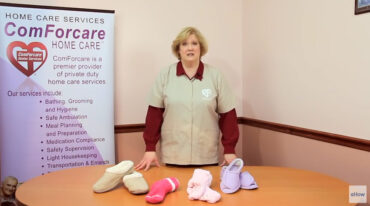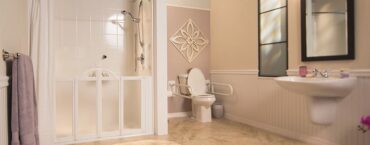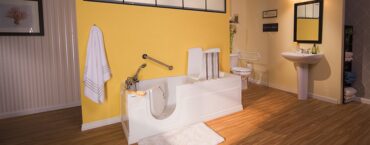Assistive technology is any service or tool that helps the elderly or disabled do the activities they have always done but must now do differently. These tools are also sometimes called “adaptive devices.”
Such technology may be something as simple as a walker to make moving around easier or an amplification device to make sounds easier to hear (for talking on the telephone or watching television, for instance). It could also include a magnifying glass that helps someone who has poor vision read the newspaper or a small motor scooter that makes it possible to travel over distances that are too far to walk. In short, anything that helps the elderly continue to participate in daily activities is considered assistive technology.
Just as older people may have many different types of disabilities, many different categories of assistive devices and services are available to help overcome those disabilities. These include the following:
- Adaptive switches. Modified switches that seniors can use to adjust air conditioners, computers, telephone answering machines, power wheelchairs, and other types of equipment. These switches might be activated by the tongue or the voice.
- Communication equipment. Anything that enables a person to send and receive messages, such as a telephone amplifier.
- Computer access. Special software that helps a senior access the Internet, for example, or basic hardware, such as a modified keyboard or mouse, that makes the computer more user friendly.
- Education. Audio books or Braille writing tools for the blind come under this category, along with resources that allow people to get additional vocational training.
- Home modifications. Construction or remodeling work, such as building a ramp for wheelchair access, that allows a senior to overcome physical barriers and live more comfortably with a disability or recover from an accident or injury.
- Tools for independent living. Anything that empowers the elderly to enjoy the normal activities of daily living without assistance from others, such as a handicapped accessible bathroom with grab bars in the bathtub.
- Job-related items. Any device or process that a person needs to do his or her job better or easier. Examples might include a special type of chair or pillow for someone who works at a desk or a back brace for someone who does physical labor.
- Mobility aids. Any piece of equipment that helps a senior get around more easily, such as a power wheelchair, wheelchair lift, or stair elevator.
- Orthotic or prosthetic equipment. A device that compensates for a missing or disabled body part. This could range from orthopedic shoe inserts for someone who has fallen arches to an artificial arm for someone whose limb has been amputated.
- Recreational assistance. New methods and tools to enable people who have disabilities to enjoy a wide range of fun activities. Examples include swimming lessons provided by recreational therapists or specially equipped skis for seniors who have lost a limb as a result of accident or illness.
- Seating aids. Any modifications to regular chairs, wheelchairs, or motor scooters that help a person stay upright or get up and down unaided or that help to reduce pressure on the skin. This could be something as simple as an extra pillow or as complex as a motorized seat.
- Sensory enhancements. Anything that makes it easier for those who are partially or fully blind or deaf to better appreciate the world around them. For instance, a telecaption decoder for a TV set would be an assistive device for a senior who is hard of hearing.
- Therapy. Equipment or processes that help someone recover as much as possible from an illness or injury. Therapy might involve a combination of services and technology, such as having a physical therapist use a special massage unit to restore a wider range of motion to stiff muscles.
- Transportation assistance. Devices for elderly individuals that make it easier for them to get into and out of their cars or trucks and drive more safely, such as adjustable mirrors, seats, and steering wheels. Services that help the elderly maintain and register their vehicles, such as a drive-up window at the department of motor vehicles, would also fall into this category.
WHAT ARE THE BENEFITS OF ASSISTIVE TECHNOLOGY?
For many seniors, assistive technology makes the difference between being able to live independently and having to get long-term nursing or home-health care. For others, assistive technology is critical to the ability to perform simple activities of daily living, such as bathing and going to the bathroom.
According to a 1993 study conducted by the National Council on Disability, 80 percent of the elderly persons who used assistive technology were able to reduce their dependence on others. In addition, half of those surveyed reduced their dependence on paid helpers, and half were able to avoid entering nursing homes. Assistive technology can also reduce the costs of care for the elderly and their families. Although families may need to make monthly payments for some pieces of equipment, for many, this cost is much less than the cost of home-health or nursing home care.
HOW CAN I TELL IF ASSISTIVE TECHNOLOGY IS RIGHT FOR ME?
Seniors must carefully evaluate their needs before deciding to purchase assistive technology. Using assistive technology may change the mix of services that a senior requires or may affect the way that those services are provided. For this reason, the process of needs assessment and planning is important.
Usually, needs assessment has the most value when it is done by a team working with the senior in the place where the assistive technology will be used. For example, an elderly person who has trouble communicating or is hard of hearing should consult with his or her doctor, an audiology specialist, a speech-language therapist, and family and friends. Together, these people can identify the problem precisely and determine a course of action to solve the problem.
By performing the needs assessment, defining goals, and determining what would help the senior communicate more easily in the home, the team can decide what assistive technology tools are appropriate. After that, the team can help select the most effective devices available at the lowest cost. A professional member of the team, such as the audiology specialist, can also arrange for any training that the senior and his or her family may require to use the equipment needed.
The following case study shows how conducting a needs assessment and working with a team improved the quality of life for one elderly woman and her family:
The results were wonderful. Together, the team helped Christina get a good hearing aid that enabled her to hear well again. A special magnification device and telecaption decoder on the TV meant that she could watch television without having to bother the children. More assistive technology enabled her to talk on the telephone and use the computer as easily as ever before. In the end, the operations to remove Christina’s cataracts were successful, and she could see better than before, but she still used the magnifying screens and telecaption devices for convenience. Combined with her new hearing aid, each item convinced Christina that assistive technology can make a big difference indeed.
When considering all the options of assistive technology, it is often useful to look at the issue in terms of high tech and low-tech solutions. Seniors must also remember to plan ahead and think about how their needs might change over time. High-tech devices tend to be more expensive but may be able to assist with many different needs. Low-tech equipment is usually cheaper but less adaptable for multiple purposes. Before buying any expensive piece of assistive technology, such as a computer, be sure to find out if it can be upgraded as improvements are introduced. Whether you are conducting a needs assessment or trying to make a decision after such an assessment, it is always a good idea to ask the following questions about assistive technology:
Case Study
At the age of 66, Christina did not feel old. After her divorce, she became more active than ever in her church and began doing all the things she had been wanting to do for years. She moved into her daughter Kelly’s house to save money and enjoyed her garden there in the backyard. The only thing that slowed her down was that her hearing and vision were beginning to go. She could no longer appreciate music the way she used to or see well enough to read for more than a few minutes without getting a headache. At the same time, Christina’s medical condition was beginning to affect her life at home. Kelly’s children complained that Christina turned the television set up so loud that they could not concentrate on their homework.
Although Christina was in good health otherwise, the hearing and vision problems eventually got so bad that she went to her doctors for a checkup. Her ophthalmologist told her that she had cataracts and would need operations to have them removed from her eyes. The audiologist said that she would need to get a hearing aid. Both doctors also said that she would require rehabilitative services. Fortunately, Christina was still able to take charge of the situation and find a solution as quickly as possible. While waiting to get her eye operations done, she had her doctors set up a needs assessment team to explore other options she could pursue to make life easier both before and after her surgery. Christina worked closely with the ophthalmologist and audiologist and had physical and recreational therapists come to the house, They spent a full week analyzing Christina’s condition and her home environment. Then, they looked at alternatives that would allow Christina to remain as active as possible, while still addressing her family’s concerns.
- Does a more advanced device meet more than one of my needs?
- Does the manufacturer of the assistive technology have a preview policy that will let me try out a device and return it for credit if it does not work as expected?
- How are my needs likely to change over the next six months? How about over the next six years or longer?
- How up-to-date is this piece of assistive equipment? Is it likely to become obsolete in the immediate future?
- What are the tasks that I need help with, and how often do I need help with these tasks?
- What types of assistive technology are available to meet my needs?
- What, if any, types of assistive technology have I used before, and how did that equipment work?
- What type of assistive technology will give me the greatest personal independence?
- Will I always need help with this task? If so, can I adjust this device and continue to use it as my condition changes?
HOW CAN I PAY FOR ASSISTIVE TECHNOLOGY?
Right now, no single private insurance plan or public program will pay for all types of assistive technology under any circumstances. However, Medicare Part B will cover up to 80 percent of the cost of assistive technology if the items being purchased meet the definition of “durable medical equipment.” This is defined as devices that are “primarily and customarily used to serve a medical purpose, and generally are not useful to a person in the absence of illness or injury.”
To find out if Medicare will cover the cost of a particular piece of assistive technology, call 1-800-MEDICARE (1-800-633-4227, TTY/TDD: 1-877-486-2048). You can also find answers to your questions by visiting the website at www.medicare.gov on the Internet.
Depending on where you live, the state-run Medicaid program may pay for some assistive technology. Keep in mind, though, that even when Medicaid does cover part of the cost, the benefits usually do not provide the amount of financial aid needed to buy an expensive piece of equipment, such as a power wheelchair. To find out more about Medicaid in your State call the toll free number for your State. A list of toll free numbers can be reached through the following website: http://www.cms.hhs.gov/medicaid/allStateContacts.asp
Seniors who are eligible for veterans’ benefits should definitely look into whether they can receive assistance from the Department of Veterans Affairs (DVA). Many people consider the DVA to have a model payment system for assistive technology because the agency has a structure in place to pay for the large volume of equipment that it buys. The DVA also invests in training people in how to use assistive devices. For more information about DVA benefits for assistive technology, call the VA Health Benefits Service Center toll-free at 1-877-222-VETS or visit the department’s website at: http://www1.va.gov/health/index.asp
Private health insurance and out-of-pocket payment are two other options for purchasing assistive technology. Out-of-pocket payment is just that; you buy the assistive technology yourself. This is affordable for small, simple items, such as modified eating utensils, but most seniors find that they need financial aid for more costly equipment. The problem is that private health insurance often does not cover the full price of expensive devices, such as power wheelchairs and motor scooters.
Subsidy programs provide some types of assistive technology at a reduced cost or for free. Many businesses and not-for-profit groups have set up subsidy programs that include discounts, grants, or rebates to get consumers to try a specific product. The idea is that by offering this benefit, the program sponsors can encourage seniors and people with disabilities to use an item that they otherwise might not consider. Obviously, elderly people should be careful about participating in subsidy programs that are run by businesses with commercial interests in the product or service because of the potential for fraud.
WHERE CAN I LEARN MORE ABOUT ASSISTIVE TECHNOLOGY?
Most states have at least one agency that deals specifically with assistive technology issues. The Assistive Technology Act (Tech Act) provides funds to states for the development of statewide consumer information and training programs. A listing of state tech act programs is available at:
Some area agencies on aging (AAA) have programs or link to services that assist older people obtain low-cost assistive technology. You can call the Eldercare Locator at 1-800-677-1116 or visit the website www.eldercare.gov to locate your local AAA. In addition local civic groups, religious and veterans’ organizations, and senior centers may be able to refer you to assistive technology resources.
The following resources provide information on assistive technology products and services.
DisabilityInfo.gov
http://www.disabilityinfo.gov
This site is designed to serve as a “one-stop” electronic link to an enormous range of useful information to people with disabilities and their families.
ABLEDATA
http://www.abledata.com
800/227-0216 or 301/608-8998
TTY 301/608-8912
ABLEDATA is a federally funded project whose primary mission is to provide information on assistive technology and rehabilitation equipment available from domestic and international sources to consumers, organizations, professionals, and caregivers within the United States.
Solutions: Assistive Technology for People with Hidden Disabilities
http://www.uiowa.edu/infotech/Solutions.pdf
This resource guide provides information on adapted devices for people who have memory problems.






